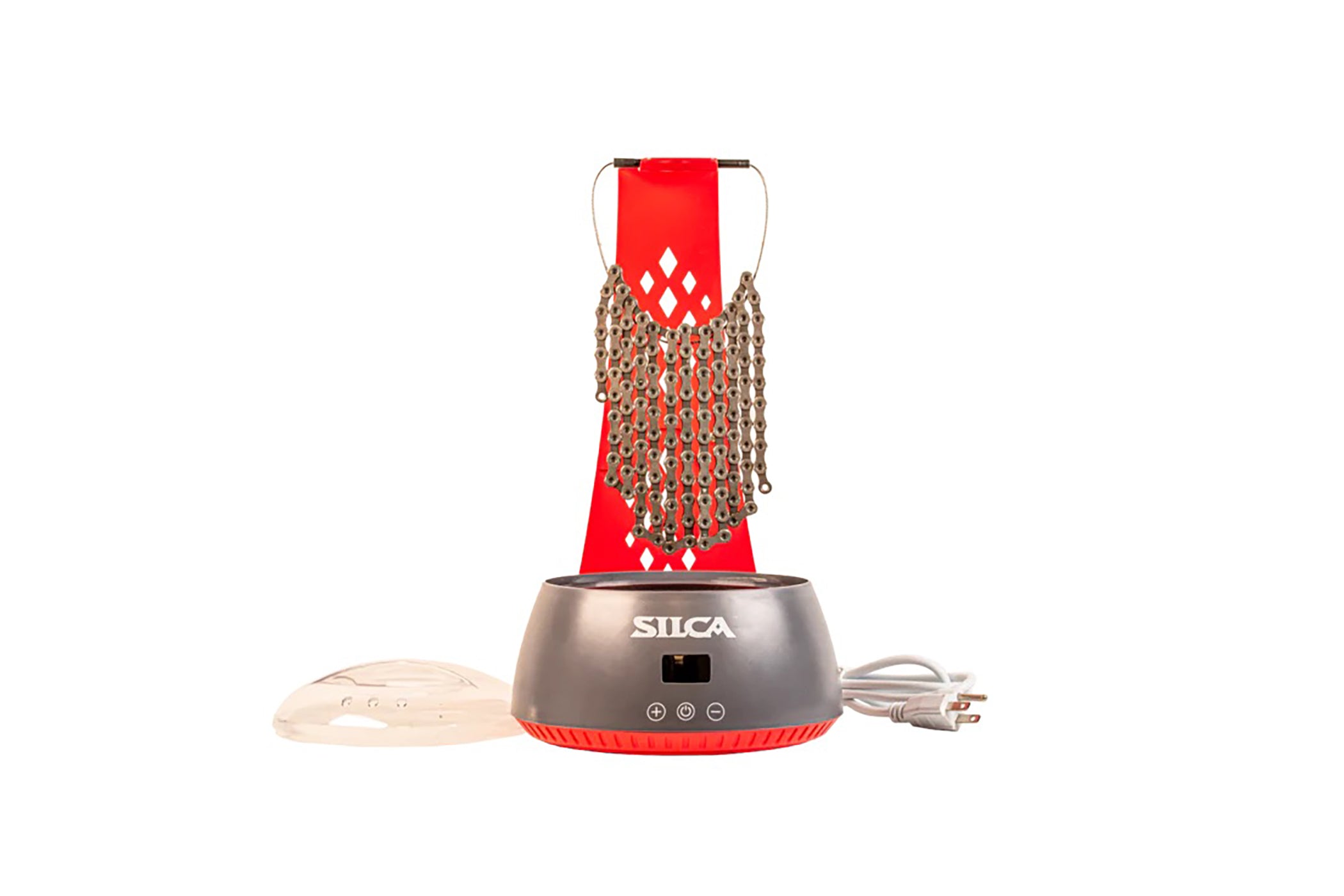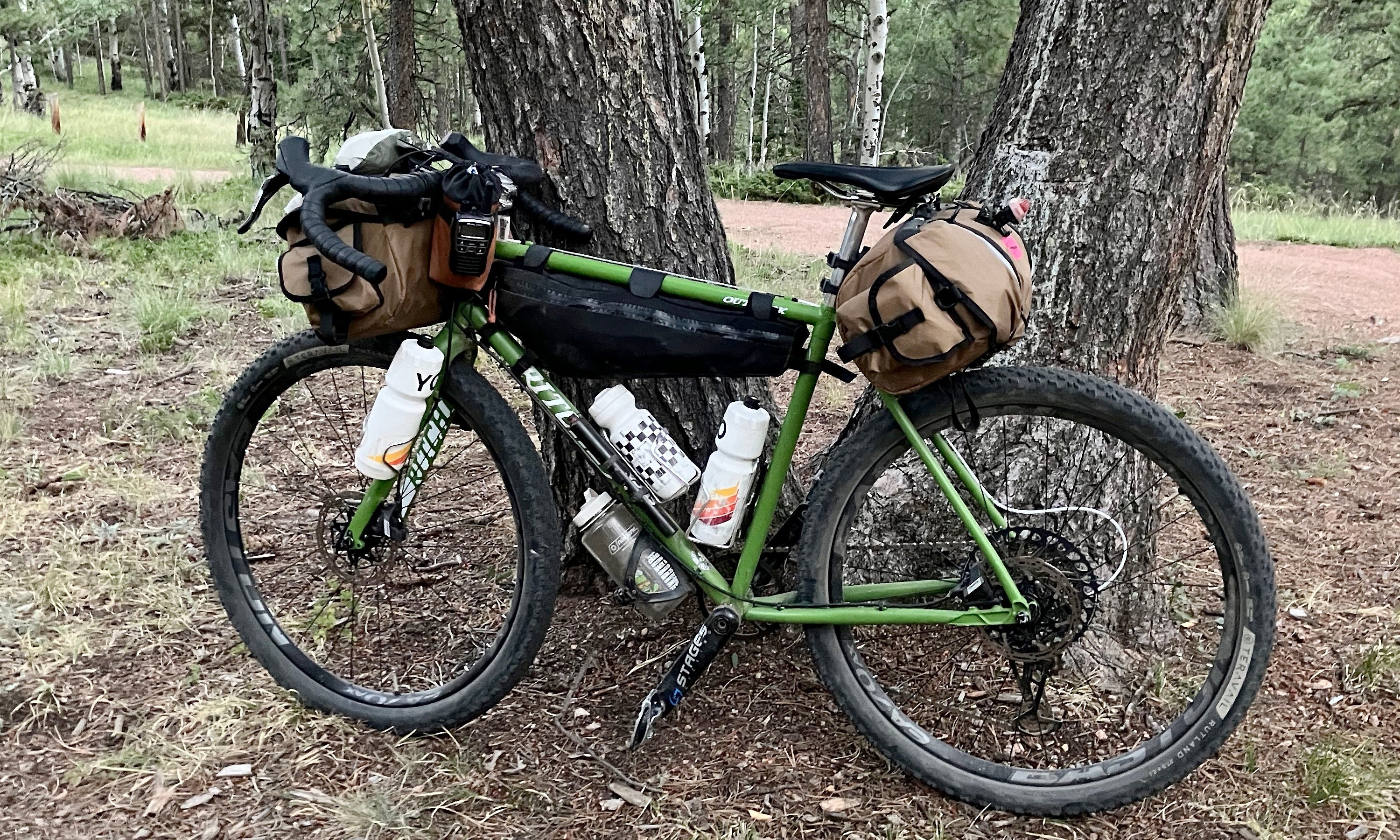For years, I used a popular “dry” chain lube called Rock-N-Roll Gold. It was affordable, easy to use, easy to find, and it kept my drivetrain fairly clean. According to independent testing, it was also one of the fastest lubes on the market. OVer time though, I've started competing in more endurance gravel and mountain bike races and I quickly discovered this lube’s biggest weakness: longevity.
When I did the Unbound 100 in 2017, my bike started squeaking several miles before the halfway point. It got so loud it started driving me and the other riders in my paceline insane. I’d applied multiple generous coats of lube the night before but after only 30 miles it was completely dry and the chain and cassette were caked in dirt and dust.
After that experience, I began testing a lot of different “dry” lubes, including Rock-N-Roll Extreme, which is supposed to be a bit more robust. The conclusion I’ve come to is that all “dry” lubes suck for endurance off-road races. Even if they worked on my training rides, there was something about the intensity of racing that just caused them to degrade faster. In multiple races from 2018-2021, anytime I used a “dry” lube my chain would cake up with dirt and dust and get super noisy and gritty feeling long before the finish.
Fortunately, there are better alternatives that can go the distance while also making your drivetrain more efficient. I’ll cover the wet lubes and wax products I use for the toughest gravel and mountain bike races and my chain lube plan for Unbound Gravel this year.
Hot Take? Wet Lube is Better Than Dry Lube
When I started cycling, the apocryphal knowledge passed down to me was that wet lubes are better in wet conditions while dry lubes are better in dry and dusty conditions. Because dry lubes are “dry,” they don’t attract dirt and dust, keeping your chain cleaner and more efficient. This is true until the lubricant wears out.
 Some of the (many) lubes that now sit unused in my tool bench after finding my favorites.
Some of the (many) lubes that now sit unused in my tool bench after finding my favorites.
Most common dry lubes are mostly made up of a carrier liquid with a small amount of lubricant suspended in it. The carrier flushes out dirt and dust and deposits the “dry” lube between the links and rollers of the chain. The problem is there’s very little lubricant left on the chain and it often doesn’t adhere well so it rarely lasts through tough long-distance races.
I had a conversation with chain expert and Shimano’s MTB Product Manager, Nick Murdick, and he explained the key issue is existing grease, lube, and grime on the chain.
“It’s important to understand what is and isn’t compatible with the factory grease,” he explained. “For the most part, anything dry or wax-based isn’t going to live up to its potential unless the factory grease and any other chain lube are completely removed first. They will do a good job of reducing friction when fresh and they can stay very clean, but they also tend to need more frequent application and can be washed away easily in wet conditions.”
It’s a bit counterintuitive, especially considering what we’ve been told by lube marketing, but I’ve consistently found that “wet” lubes hold up much better during dry and dusty endurance races.

For wet lubes, Synergetic is my favorite by far. Photo: Silca
“Wet lubes can mean lubes meant for wet riding or simply oil-based lubricants that stay liquid,” Murdick said. “Some of those oils work great in dry conditions so it’s a bit of an unfortunate term. They are completely compatible with the factory grease so you can simply apply them on top of a fresh chain.”
Yes, the oil or “wet” lube will attract some dirt and dust, but the lubricant stays effective for much longer. If you don’t like the look of a grimy chain, you can simply wipe the dirt, dust, and grime on the surface away, and the chain will look fairly clean again while still being lubricated.
My life got a lot better when I first switched over to wet lubes in 2019. My chains easily went the distance in 12-hour MTB races and long-distance events like SBT GRVL. In training, it was also nice to lube my chain less. Instead of every 1-2 rides, I’d re-lube every 4-6 rides. The main trade-offs were cleaning more grime off my drivetrain and greasy chain marks on my fingers when working on my bikes.

Silca SYNERGETIC Wet Lube
$12.99
After trying many options, I've pretty much settled on Silca Synergetic being the best wet lube I’ve ever used. Based on independent testing by Zero Friction Cycling, it’s also been shown to be one of the fastest lubes on the market. It also lasts a really long time and compared to many wet lubes it actually stays decently clean.
Synergetic is the lube I recommend to anyone seeking the most performance for the least amount of hassle. I think it's also the best lube option for extremely wet and muddy conditions. It's the lube I chose to run at Unbound in 2023 in anticipation of bad mud and thunderstorms throughout the day. Had the forecast been a bit drier though, I would have stuck with what I consider the best overall lube option: Wax.
Immersion Wax Is the Overall Best "Lube"
 Waxed chains greatly reduce wear. I used this old X01 cassette for over 7,000 miles and still had a lot of life left when I retired it. The white stuff on the chain is wax.
Waxed chains greatly reduce wear. I used this old X01 cassette for over 7,000 miles and still had a lot of life left when I retired it. The white stuff on the chain is wax.
Traditional drip lubes are popular for a good reason: they’re easy to use. A rider with little to no mechanical experience can figure out how to drip lube onto a chain and wipe it off. But, if you want maximum performance and efficiency, especially in tough, dusty conditions, nothing beats a waxed chain.
Compared to traditional drip lubes, waxed chains can save you an additional 6-8 watts. That doesn’t sound like a ton, but it’s pretty low-hanging fruit. Compared to other drivetrain efficiency upgrades like ceramic bottom brackets or oversized pulley wheels (which cost hundreds of dollars) it provides more gains for A LOT less money.
 Most of the excess wax seen here flakes off and your chain stays clean and silent for hundreds of miles.
Most of the excess wax seen here flakes off and your chain stays clean and silent for hundreds of miles.
For ultra-long races like Unbound, the improved efficiency of a waxed chain is the most appealing benefit. As "regular" lube gets dirty, the friction in the chain increases, which costs you more energy. When dirt and dust get stuck to wax it gets shed away. Plenty of wax remains adhered to the metal inside the chain, keeping friction low so that 6-8 watt savings over drip lube will grow bigger over time (until the wax fully degrades). When you’re riding for over 12 hours, little gains like this add up.
There's the cleanliness too. You can touch a waxed chain with your bare hands and it won’t leave any marks on your skin. It also creates a physical barrier between the metal on metal wear points in your drivetrain. That means your chain, chainrings, and cassette will all last a lot longer, in ideal cases, well over 10,000 miles, which saves you money in the long run.
When the benefits for something as cheap and simple as waxing are so big, I personally don’t see any reason not to go for it (unless the conditions are super wet and muddy, but I’ll get to that later).
Chain Waxing Is Easy Once You Get the Hang of It
Chain waxing has been around for a long time, but it started getting a lot more hype in only the last 5 or so years. More and more riders have become dedicated chain waxers and nearly every serious racer here at TPC rides a waxed chain. Waxers are still in the minority though.
Waxing a chain can be intimidating if you’ve never done it. I was definitely too intimidated (and lazy), so I waited years before trying it. But after starting, it has become part of my routine, and I don’t stress about it anymore.
Like painting, the most difficult part is the initial prep. Prep is the only part you really need to get right. Everything after that is fairly easy. I’ll quickly cover the basics of what I do to try and show how cheap and easy it really is.
Tools, Supplies, and Cost for Chain Waxing:
- Small slow cooker (~$15)
- Quick link tool (~$15, to remove chain)
- Silca Chain Stripper ($36)
- Wax ($40 for Silca Secret Chain blend)
- A pack of spare quick links (~$10-20)
- A new chain… maybe (~$35-90)
You could spend as little as $150 and get a good wax setup that will get you through tens of thousands of miles. $150 sounds like a lot compared to a cheap bottle of lube, but a bag of wax will last a VERY long time. The wax currently in my crock pot is over 2 years old. I’m good about rinsing my chains off with hot (or boiling) water before tossing them in, so the wax has stayed very clean and I can likely get a lot more mileage out of it. The cost is also offset by reduced wear because you won’t have to replace your chain, chainrings, or cassette as often.
The main recurring cost will be quick links. Technically, Shimano and SRAM say not to reuse their 11 and 12-speed quick links, but (note: TPC doesn’t officially condone this) I reuse quick links until they start to feel loose. If there isn’t a solid snap when replacing a quick link, I’ll replace it. I do always use a brand new quick link before races, just for safety.
The Easiest Way(s) to Prep a Chain for Wax
 One of my prepped chains free of all factory grease.
One of my prepped chains free of all factory grease.
To prep a chain for wax, it needs to be stripped down to bare metal. Wax needs to stick to bare metal so there can’t be any lube or grease or grime on your chain. I prefer starting with a brand-new chain because all you need to worry about is removing the factory lube or grease. I’m not a fan of waxing a used chain, but you can do it as long as you're extra thorough with cleaning and prepping it.

Silca Chain Stripper & Wax Prep 16oz
$36.00
The traditional way to remove factory grease from a chain is to soak it in mineral spirits and denatured/isopropyl alcohol, which you can find in any hardware store. These days though, I prefer Silca’s Chain Stripper. It’s a single step — just soak a chain in it for ~15 minutes, rinse it off, and then wax it straight after.
Chain Stripper makes waxing a chain super easy and the solvent itself is a little more environmentally friendly. It also has a primer that helps the wax stick. At TPC, we use Chain Stripper in our ultrasonic cleaner, but at home, I just use an old mason jar to soak my chains.

Stripping and prepping 2 chains at once was a breeze.
One bottle of Chain Stripper is enough to strip multiple chains. I’ve used my mason jar of Chain Stripper to prep 5 chains so far and I’m still getting really good results in terms of wax adhesion. It can absorb a lot of grease, and I’m kind of curious to push the limit and find out how long you can go before you need fresh solvent. One bottle of Chain stripper goes a long way, and I think it’s worth using just for the simplicity.
Chain Waxing Option 1: Hot Met / Immersion Wax
 Photos: Molten Speed Wax
Photos: Molten Speed Wax

Silca Secret Chain Blend - Hot Melt Wax
$40.00
Once a chain is stripped, you can then immerse it in your hot wax of choice. I recommend Silca’s Secret Chain Blend. It has some additives that improve speed and longevity, and I prefer Silca because it really is the current industry benchmark for wax products.
Drop the chain into a crock pot filled with wax, turn it on, and let it all melt together. I thread my chain onto an old spoke so I can swish it around and pull it out, but you could also use a coat hanger or piece of wire. Let the chain sit in the liquid wax for around 10 minutes so the wax will get between the links and rollers. Pull it out and let it dry. The links will be stiff, but you can break them up by hand and reinstall your chain.
When it’s time to re-wax, you can put the chain straight back into the slow cooker and repeat ad infinitum. If your chain is especially dirty, it's best to boil up some water (I use an electric kettle) and rinse the chain to remove any dirt, grime, or old wax so it doens't contaminate your pot of clean wax.

Silca Strip Chip Chain Degreaser
$24.00
If using a jar full of Chain Stripper isn’t appealing, there’s also a product that will potentially make waxing even easier — the Silca Strip Chip. You put this chip in a pot of wax with a brand new chain (it HAS to be brand new because it only works on factory grease). It strips and waxes your chain in a single step by turning the factory grease into a wax-like polymer.

Silca's Chain waxing station is the fanciest of crock pots. Precise temperature control maximizes wax performance.

Silca Chain Waxing System
$99.00
I haven’t tested the Strip Chip yet, mainly because I don’t need to prep any new chains right now, but people are super excited about it. For it to work though, it requires more precise temperature control of the wax than my $15 Elite Gourmet can achieve (I’d have to use a candy thermometer and monitor it the whole time). Silca has released its own “Chain Waxing Station” which provides finer temperature control to make using its Strip Chip easier.
Chain Wax Option 2: Drip Wax Chain Coatings
 Super Secret goes on thick, penetrates deep without heat, and coats the key parts of the chain.
Super Secret goes on thick, penetrates deep without heat, and coats the key parts of the chain.
If removing your chain and dropping it in a slow cooker is too much of a hassle for you, drip wax can give you wax-like performance with less work.
A drip wax is NOT the same as a regular wax-based lubricant (this can get confusing). It is a paraffin wax, just like the wax you’d use in a slow cooker, but it has been emulsified in a carrier liquid. You will know it’s drip wax and not "regular" lube because you will still need to strip the chain to bare metal for it to adhere. But instead of using a crockpot, you just simply drip it onto the chain rollers. It will penetrate and coat the rollers. You let it set (anywhere from 30 minutes to 12 hours) and the end result will be similar to a hot melt or immersion wax.
Drip wax is not quite as good as true immersion waxing, but it gets very close and it is much easier to live with for a lot of riders.
I’ve been trying and switching between a few options — Silca Super Secret, CeramicSpeed UFO, and AbsoluteBlack GRAPHENlube — and all work very similarly. Zero Friction Cycling has actual test data, but I don’t really experience any differences in longevity so I just use Silca Super secret because we have a lot of it here at TPC.

Silca Super Secret Chain Coating
$16.00

CeramicSpeed UFO Drip All Conditions Chain Lube 100 ml
$24.00
I actually use a combination of immersion and drip waxing in my regular routine. I get 200-300 miles out of an immersion wax job, but instead of taking my chain off and rewaxing every time, I just apply a drip wax coating to keep the chain lubricated. I’ll keep doing this until I have time in my schedule to take my chains off to re-wax them in the crock pot. This has made life super easy, and it’s one of the main reasons I’ve been able to stick with waxing for the last 2+ years.
Organization, Rain, and Mud: The Downsides of Waxed Chains

Really, the hardest part of waxing a chain is staying organized. You have to plan when you wax. I used to be the type of rider who would lube his chain right before heading out the door, but I can’t do that anymore with wax.
Even with simpler drip wax coatings, they need to dry for at least 30 minutes before your ride. Ideally, for the best performance, you would let it dry for up to 12 hours. If you struggle to think that far ahead, waxing can get annoying. I’ve had many instances where I’m riding the next morning, but I suddenly realize that my chain needs a re-wax just as I’m getting into bed.
To try and avoid this, I’ve gotten into the habit of applying a drip wax coating right after getting home from certain rides. This means my bike will be ready if I happen to want to ride the next day too.
Then there’s the issue of rain and mud. Like “dry” drip lubes, wax isn’t as robust as wet lube when exposed to moisture. On a fully dry day, even with a few creek crossings, a waxed chain will easily make it to the end of a 200 mile race like Unbound.
But if there’s rain or mud in the mix, it won’t last nearly as long. I’ve actually used wax in some insanely gnarly conditions (just check out my 2024 Old Man Winter Recap) and it has done okay. Wax repels water, so it won’t just wash away immediately. In the wettest and worst mud imaginable, I’ve managed to get ~40-50 miles out of Silca Secret Chain Blend before it started making noise. In less extreme rain and mud, I’ve managed a more reasonable ~60-100 miles.
My Unbound 2024 Chain Lube Plan

Unbound 2022, Checkpoint 2 - My waxed chain made it through the mud at mile 120, but didn't last long after that.
A race like Unbound Gravel can be bone dry, or we could end up in a situation like last year where riders spend hours in the worst mud imaginable.
In 2022, my waxed chain made it to the end, despite some heavy rain and mud in the middle of the race, but by the last 20-30 miles it was really loud and squeaky. I had brought a bottle of Silca Super Secret, which I applied at the checkpoint at mile 160 checkpoint, but it didn’t really do anything because it didn’t have time to dry and set.
My plan this year is to wax my chain and hope for a dry race, but I also have wet lube on hand if the weather turns.
I will be bringing my crock pot to Kansas with me, and I plan to re-wax my chain after scouting the opening miles of the course the day before the race. IF you don’t want to travel with a crock pot, then I’d wax the chain just before leaving, then apply a fresh drip wax coating the nice before the start.
If I run into any serious moisture or mud and my chain starts protesting, then I’ll just sacrifice my nice waxed chain and put Silca Synergetic wet lube on it. I’ll keep a bottle with my support crew no matter what, and if the forecast is looking particularly bad, I may carry a bottle on the bike too. Synergetic bottles are fairly small, so it won’t take up much space in my hydration pack or top tube bag.
With a waxed chain and wet lube as a back-up, I’m pretty confident my chain will stay as fast, efficient, and quiet as possible until the end of Unbound... as long as my legs can make it that far!

























